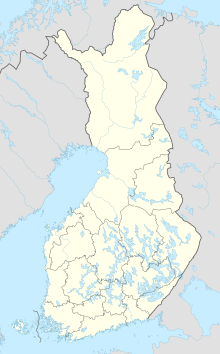Wolf cave
Coordinates: 62 ° 18 ′ 10.6 ″ N , 21 ° 39 ′ 45.3 ″ E
The Wolf Cave ( Swedish Varggrottan , Finnish Susiluola ) is a crevice in the rock of the granite rock Bötombergen (Finnish Pyhävuori ) in western Finland . It is located in the area of the city of Kristinestad in the coastal hinterland of Ostrobothnia . With an area of around 400 m², it is the largest cave in Finland.
Finland was covered by an ice sheet during the Vistula Ice Age, which fundamentally reshaped the surface of the earth, so that any older traces of settlement can no longer be found. The wolf cave withstood the pressure of the ice masses, so that pre-glacial soil layers were preserved inside. During excavations in 1996, various stone objects were found in the cave, which some archaeologists interpret as artifacts .
According to a controversial dating, some of the alleged stone tools or worked stones date from the Eem warm period around 120,000 years ago. If this assignment is correct, it would be the oldest evidence of human settlement in Finland. If the objects are actually artifacts, the Neanderthal man seems likely to be the originator, whose presence in the Nordic countries has not yet been proven.
The cave has not been accessible to visitors since 1998, but a documentation center has been set up on an adjacent site, which records several thousand visitors every year.
Web links
- Wolf Cave - Life Before the Ice Age - Documentation Center website
- Ralf Norrman: A Pre-Ice Age Archaeological Find in Lappfjärd, Finland (English)

